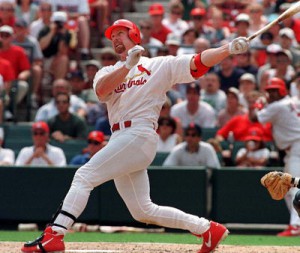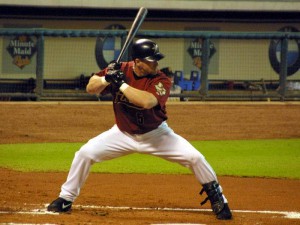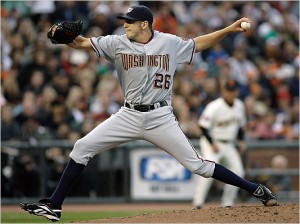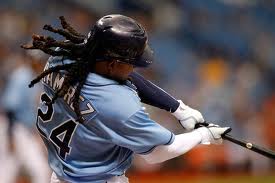A viewing of the HBO special “Freakonomics,” which turns chapters of the popular book into little mini vignettes, along with a conversation with my father prompted me to investigate the aspects of human behavior with regard to incentives when considering the rise of Steroid use by major league baseball players in the late 1990s. One of the overriding themes in Freakonomics is that any aspect of human behavior can be predicted by analyzing the incentives facing those persons when making a choice.
So the question here is, were the growing incentives to players in terms of rising baseball salaries directly tied to the growing use of Steroids in the mid 1990s?
Steroids had been around for many years prior to appearing en-masse in Baseball. The most infamous use came from the East German Olympic teams during the late 70s and early 80s, who systematically doped their own athletes (mostly without the athlete’s knowledge) from 1971 until 1990. But seemingly only after the 1988 Seoul Olympics saw sprinter Ben Johnson test positive for one steroid and admitted the use of a host of other Steroids, Testosterone and HGH substances did the “Steroid Era” in baseball start. In fact, 1988 is also acknowledged as the beginning of the era in the Mitchell Report (per Section D of the Summary, pg SR-14). However, I’d argue that the mainstream usage of Steroids didn’t occur for a few years after (see the rise of 45+ homer seasons below).
Here’s a chart of Mean and Median US household income from 1974-2010, with the Minimum and Maximum MLB salaries, the Average MLB salary, that MLB salary listed as a multiple of the US mean income, and the number of 45+ home run seasons seen per year:
| Year | Median Income: Current Dollars | Mean Income: current dollars | Minimum MLB Salary | Maximum MLB Salary | Average MLB Salary | Avg MLB salary as multiple of Mean US income | # of 45+ Homer Seasons |
| 2012 | $480,000 | $32,000,000 | |||||
| 2011 | $414,000 | $32,000,000 | $3,305,393 | 0 | |||
| 2010 | $49,445 | $67,530 | $400,000 | $33,000,000 | $3,297,828 | 49 | 1 |
| 2009 | $49,777 | $67,976 | $400,000 | $33,000,000 | $3,240,206 | 48 | 3 |
| 2008 | $50,303 | $68,424 | $390,000 | $28,000,000 | $3,154,845 | 46 | 1 |
| 2007 | $50,233 | $67,609 | $380,000 | $23,428,571 | $2,944,556 | 44 | 4 |
| 2006 | $48,201 | $66,570 | $327,000 | $21,680,727 | $2,866,000 | 43 | 5 |
| 2005 | $46,326 | $63,344 | $316,000 | $26,000,000 | $2,632,655 | 42 | 5 |
| 2004 | $44,334 | $60,466 | $300,000 | $22,500,000 | $2,486,000 | 41 | 4 |
| 2003 | $43,318 | $59,067 | $300,000 | $22,000,000 | $2,555,000 | 43 | 4 |
| 2002 | $42,409 | $57,852 | $300,000 | $22,000,000 | $2,383,000 | 41 | 4 |
| 2001 | $42,228 | $58,208 | $300,000 | $22,000,000 | $2,264,000 | 39 | 9 |
| 2000 | $41,990 | $57,135 | $200,000 | $15,714,286 | $1,987,000 | 35 | 4 |
| 1999 | $40,696 | $54,737 | $200,000 | $11,494,794 | $1,726,000 | 32 | 6 |
| 1998 | $38,885 | $51,855 | $200,000 | $14,936,667 | $1,378,000 | 27 | 9 |
| 1997 | $37,005 | $49,692 | $200,000 | $10,000,000 | $1,314,000 | 26 | 3 |
| 1996 | $35,492 | $47,123 | $200,000 | $9,237,500 | $1,101,000 | 23 | 6 |
| 1995 | $34,076 | $44,938 | $109,000 | $9,237,500 | $1,094,000 | 24 | 1 |
| 1994 | $32,264 | $43,133 | $100,000 | $6,300,000 | $1,154,000 | 27 | 0 |
| 1993 | $31,241 | $41,428 | $100,000 | $6,200,000 | $1,062,000 | 26 | 3 |
| 1992 | $30,636 | $38,840 | $100,000 | $6,100,000 | $1,012,000 | 26 | 0 |
| 1991 | $30,126 | $37,922 | $100,000 | $3,800,000 | $845,383 | 22 | 0 |
| 1990 | $29,943 | $37,403 | $100,000 | $3,200,000 | $589,483 | 16 | 1 |
| 1989 | $28,906 | $36,520 | $60,000 | $2,766,667 | $489,539 | 13 | 1 |
| 1988 | $27,225 | $34,017 | $60,000 | $2,340,000 | $430,688 | 13 | 0 |
| 1987 | $26,061 | $32,410 | $60,000 | $2,127,333 | $402,579 | 12 | 3 |
| 1986 | $24,897 | $30,759 | $60,000 | $2,800,000 | $410,517 | 13 | 0 |
| 1985 | $23,618 | $29,066 | $60,000 | $2,130,300 | $368,998 | 13 | 0 |
| 1984 | $22,415 | $27,464 | $30,000 | $2,500,000 | $325,900 | 12 | 0 |
| 1983 | $20,885 | $25,401 | $30,000 | $2,500,000 | $289,000 | 11 | 0 |
| 1982 | $20,171 | $24,309 | $30,000 | $2,500,000 | $245,000 | 10 | 0 |
| 1981 | $19,074 | $22,787 | $30,000 | $2,500,000 | $195,500 | 9 | 0 |
| 1980 | $17,710 | $21,063 | $30,000 | $2,500,000 | $146,500 | 7 | 1 |
| 1979 | $16,461 | $19,554 | $16,000 | $1,170,000 | $121,900 | 6 | 3 |
| 1978 | $15,064 | $17,730 | $16,000 | $700,000 | $97,800 | 6 | 1 |
| 1977 | $13,572 | $16,100 | $16,000 | $700,000 | $74,000 | 5 | 1 |
| 1976 | $12,686 | $14,922 | $16,000 | $700,000 | $52,300 | 4 | 0 |
| 1975 | $11,800 | $13,779 | $16,000 | $670,000 | $44,676 | 3 | 0 |
| 1974 | $250,000 | $40,839 | 0 |
There’s several landmark seasons of note in terms of escalating Salaries through this list. By year:
- 1975 saw Catfish Hunter become the first “true” Free Agent subject to bidding wars among teams, and signed a 5yr/$3.35M deal with the Yankees that resulted in his league-leading salary to nearly triple the league leading salary from 1974.
- 1979 saw Nolan Ryan become the first $1million/year player.
- In 1982 George Foster became the first $2M/year player.
- By 1989, Kirby Puckett became baseball’s first $3M/year player.
- In 1992, Barry Bonds hit free agency on the heels of MVP seasons in Pittsburgh and more than doubled the previous high annual salary.
- By 1996, salaries were rising quickly; Albert Belle signs a $10M/year contract.
- 2001 saw Alex Rodriguez‘s infamous Texas contract kick in, paying him $22M/year, nearly $7M more per year than the next closest player (Kevin Brown, who signed baseball’s first 9-figure contract).
- Rodriguez opted out of that same contract and re-negotiated the terms even higher with the Yankees, eclipsing the $30M/year mark by 2009.
Meanwhile, take note of the red-colored years of 1996 to 2001, the core of the Steroid Era. 1996 saw no less than Six players eclipse the 45 home run barrier, including Brady Anderson in a complete aberration year for the lead-off hitter (he hit 50 homers in 1996 but averaged just 19 per 162 game segment and never hit more than 24). Suddenly in 1998 no less than Nine players eclipsed the mark, lead by the Mark McGwire/Sammy Sosa home-run hitting competition that transfixed the nation and “saved” baseball. Too bad we now know what America didn’t know then; that both players were using Performance Enhancing drugs to beef up, help power out baseballs and take advantage of a slew of new ballparks that opened in the era that featured cozier dimensions and more offense.
By 2002, enough pressure from the front office towards the player’s union had taken place to start testing, leading to the infamous “anonymous survey” done of players in 2003 that resulted in “between 5-7%” of players testing positive, leading to mandatory testing in 2004. By 2008 we were back down to homer levels not seen since the early 1990s, and baseball didn’t see a single player hit the 45 homer barrier in 2011. But historically the damage has been done; the home run leader boards from the time period in question lists like a Who’s Who of steroid accusations, and a generation of middle-aged baseball writers who grew up idolizing the home run leaders of yesteryear now seems set to penalize these players for their drug usage (proven or otherwise, as with the Jeff Bagwell Hall of Fame case).
But, everything I just wrote is known narrative. Lets talk about the explosion of baseball salaries as compared to the common man. In 1975 the average MLB salary of $44k was a little more than 3-times the mean US household income, having risen only gradually over the years thanks to the Reserve clause and a non-existent players union. It was a boon for owners, who kept salaries down and profits high. But the low salaries also meant that most baseball players were considered “within reach” of the every-man in America. Players weren’t paid such ridiculously high salaries that they essentially live in a different world from the fans (as is the case today with most professional athletes in this country): these players were considered “just like us” to a certain extent, and frequently had off-season jobs, working along side the same people who paid a few bucks for a bleacher seat to cheer them on. “America’s Pastime” largely earned that title from being the only sport in town for most of the century, but was also helped along by the “within reach” argument.
By 1980, with the country in a severe recession and gas lines around the block, Joe Public slightly increased his average pay. However, Baseball players, thanks to the breaking of the reserve clause and the rise of Free agency were seeing a boom in salary hikes. By 1980, the average MLB wage was 9 times the median income in the country and a few ballplayers were making $1M/year. This ratio of US income to MLB income grew slightly over the next decade; ten years on in 1990 the average MLB wage was just 16x the US income. But changes were about to come. In 1996 the MLB salary multiple was 23-times the US mean, but by 2001 it was nearly 40-times the US mean salary. The average MLB salary more than doubled inside of these 5 years. This change coincided exactly with the beginnings of the Steroid era and also mirror the 6 year stretch where the game saw its historical rise in home runs.
So the question is: is this coincidence? Was the rise in steroid use driven by player’s desires to maximize their earning potential or was it vice-versa (i.e., players discovered steroids could escalate performance, started using and producing and that lead to the quick rise in payroll?) Or was this all more attributable to weaker pitching driven by expansion and smaller ball-parks?
I think you can make the case that home run hitters were highly compensated and were commercially the “heros” of the game (remember the “Chicks Dig the Long Ball” commercials?), and other players figured out that Steroids helped pack on muscle mass and enabled themselves to hit the ball further and faster (to say nothing of the fact that steroids enabled players to come back from injury faster and to stay stronger through the season by virtue of added muscle mass), and rode the trend. Hit 40-45 home runs one year, sign a contract extension the next. Suddenly the game found itself full of juiced up, highly compensated sluggers with a massive ethical problem.
What do you think?
Sources used:
- The Mitchell Report, December 13, 2007
- The Census Bureau historical Income charts through 2010.
- Cot’s Salary database (now part of Baseball Prospectus)
- Wikipedia list of “Highest paid players” historically.
- Baseball-reference’s list of salary leaders per year to 1985.
- SI 2005 article on Landmark Steps in Free Agency.
- Some Minimum Salaries come from BizofBaseball.com site.
- A fantastic paper titled Economic History of Baseball, from the 2002 range.
- A list of historical minimum and average salaries from baseball-reference.com.
- CBS Sports list of average baseball salaries historically.
- Baseball-reference’s List of top-10 homer leaders by season.
- A nice study of salary “firsts” at stltoday.com
| Year | Median Income: Current Dollars | Mean Income: current dollars | Minimum MLB Salary | Maximum MLB Salary | Average MLB Salary | Avg MLB salary as multiple of Mean US income | # of 45+ Homer Seasons |
| 2012 | $480,000 | $32,000,000 | |||||
| 2011 | $414,000 | $32,000,000 | $3,305,393 | 0 | |||
| 2010 | $49,445 | $67,530 | $400,000 | $33,000,000 | $3,297,828 | 49 | 1 |
| 2009 | $49,777 | $67,976 | $400,000 | $33,000,000 | $3,240,206 | 48 | 3 |
| 2008 | $50,303 | $68,424 | $390,000 | $28,000,000 | $3,154,845 | 46 | 1 |
| 2007 | $50,233 | $67,609 | $380,000 | $23,428,571 | $2,944,556 | 44 | 4 |
| 2006 | $48,201 | $66,570 | $327,000 | $21,680,727 | $2,866,000 | 43 | 5 |
| 2005 | $46,326 | $63,344 | $316,000 | $2,600,000 | $2,632,655 | 42 | 5 |
| 2004 | $44,334 | $60,466 | $300,000 | $22,500,000 | $2,486,000 | 41 | 4 |
| 2003 | $43,318 | $59,067 | $300,000 | $22,000,000 | $2,555,000 | 43 | 4 |
| 2002 | $42,409 | $57,852 | $300,000 | $22,000,000 | $2,383,000 | 41 | 4 |
| 2001 | $42,228 | $58,208 | $300,000 | $22,000,000 | $2,264,000 | 39 | 9 |
| 2000 | $41,990 | $57,135 | $200,000 | $15,714,286 | $1,987,000 | 35 | 4 |
| 1999 | $40,696 | $54,737 | $200,000 | $11,494,794 | $1,726,000 | 32 | 6 |
| 1998 | $38,885 | $51,855 | $200,000 | $14,936,667 | $1,378,000 | 27 | 9 |
| 1997 | $37,005 | $49,692 | $200,000 | $10,000,000 | $1,314,000 | 26 | 3 |
| 1996 | $35,492 | $47,123 | $200,000 | $9,237,500 | $1,101,000 | 23 | 6 |
| 1995 | $34,076 | $44,938 | $109,000 | $9,237,500 | $1,094,000 | 24 | 1 |
| 1994 | $32,264 | $43,133 | $100,000 | $6,300,000 | $1,154,000 | 27 | 0 |
| 1993 | $31,241 | $41,428 | $100,000 | $6,200,000 | $1,062,000 | 26 | 3 |
| 1992 | $30,636 | $38,840 | $100,000 | $6,100,000 | $1,012,000 | 26 | 0 |
| 1991 | $30,126 | $37,922 | $100,000 | $3,800,000 | $845,383 | 22 | 0 |
| 1990 | $29,943 | $37,403 | $100,000 | $3,200,000 | $589,483 | 16 | 1 |
| 1989 | $28,906 | $36,520 | $60,000 | $2,766,667 | $489,539 | 13 | 1 |
| 1988 | $27,225 | $34,017 | $60,000 | $2,340,000 | $430,688 | 13 | 0 |
| 1987 | $26,061 | $32,410 | $60,000 | $2,127,333 | $402,579 | 12 | 3 |
| 1986 | $24,897 | $30,759 | $60,000 | $2,800,000 | $410,517 | 13 | 0 |
| 1985 | $23,618 | $29,066 | $60,000 | $2,130,300 | $368,998 | 13 | 0 |
| 1984 | $22,415 | $27,464 | $30,000 | $2,500,000 | $325,900 | 12 | 0 |
| 1983 | $20,885 | $25,401 | $30,000 | $2,500,000 | $289,000 | 11 | 0 |
| 1982 | $20,171 | $24,309 | $30,000 | $2,500,000 | $245,000 | 10 | 0 |
| 1981 | $19,074 | $22,787 | $30,000 | $2,500,000 | $195,500 | 9 | 0 |
| 1980 | $17,710 | $21,063 | $30,000 | $2,500,000 | $146,500 | 7 | 1 |
| 1979 | $16,461 | $19,554 | $16,000 | $1,170,000 | $121,900 | 6 | 3 |
| 1978 | $15,064 | $17,730 | $16,000 | $700,000 | $97,800 | 6 | 1 |
| 1977 | $13,572 | $16,100 | $16,000 | $700,000 | $74,000 | 5 | 1 |
| 1976 | $12,686 | $14,922 | $16,000 | $700,000 | $52,300 | 4 | 0 |
| 1975 | $11,800 | $13,779 | $16,000 | $670,000 | $44,676 | 3 | 0 |
| 1974 | $250,000 | $40,839 | 0 |



